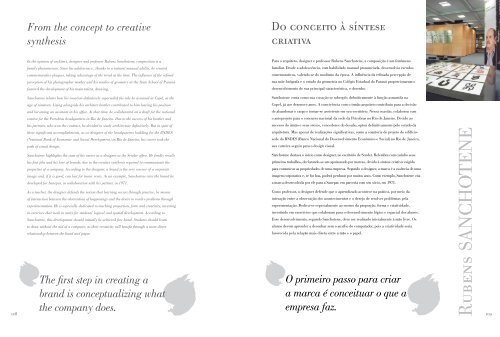Curitiba - Centro Brasil Design
Curitiba - Centro Brasil Design
Curitiba - Centro Brasil Design
You also want an ePaper? Increase the reach of your titles
YUMPU automatically turns print PDFs into web optimized ePapers that Google loves.
From the concept to creative<br />
synthesis<br />
In the opinion of architect, designer and professor Rubens Sanchotene, composition is a<br />
family phenomenon. Since his adolescence , thanks to a natural manual ability, he created<br />
commemorative plaques, taking advantage of the trend at the time. The influence of the refined<br />
perception of his photographer mother and his studies of geometry at the State School of Paraná<br />
fostered the development of his main talent, drawing.<br />
Sanchotene relates how his vocation definitively superseded the role he assumed at Copel, at the<br />
age of nineteen. Living alongside his architect brother contributed to him leaving his position<br />
and becoming an assistant in his office. At that time, he collaborated on a draft for the national<br />
contest for the Petrobras headquarters in Rio de Janeiro. Due to the success of his brother and<br />
his partners, who won the contract, he decided to study architecture definitively. But in spite of<br />
these significant accomplishments, as co-designer of the headquarters building for the BNDES<br />
(National Bank of Economic and Social Development) in Rio de Janeiro, his career took the<br />
path of visual design.<br />
Sanchotene highlights the start of his career as a designer at the Sender office. He fondly recalls<br />
his first jobs and his love of brands, due to the creative synthesis required to communicate the<br />
properties of a company. According to the designer, a brand is the very essence of a corporate<br />
image and, if it is good, can last for many years. As an example, Sanchotene cites the brand he<br />
developed for Sanepar, in collaboration with his partner, in 1971.<br />
As a teacher, the designer defends the notion that learning occurs through practice, by means<br />
of interaction between the observation of happenings and the desire to resolve problems through<br />
experimentation. He is especially dedicated to teaching proportion, form and creativity, investing<br />
in exercises that work in unity for students’ logical and spatial development. According to<br />
Sanchotene, this development should initially be achieved free hand. Students should learn<br />
to draw without the aid of a computer, as their creativity will benefit through a more direct<br />
relationship between the hand and paper.<br />
The first step in creating a<br />
brand is conceptualizing what<br />
the company does.<br />
Do conceito à síntese<br />
criativa<br />
Para o arquiteto, designer e professor Rubens Sanchotene, a composição é um fenômeno<br />
familiar. Desde a adolescência, com habilidade manual pronunciada, desenvolvia escudos<br />
comemorativos, valendo-se do modismo da época. A influência da refinada percepção de<br />
sua mãe fotógrafa e o estudo da geometria no Colégio Estadual do Paraná proporcionaram o<br />
desenvolvimento de sua principal característica, o desenho.<br />
Sanchotene conta como sua vocação se sobrepôs definitivamente à função assumida na<br />
Copel, já aos dezenove anos. A convivência com o irmão arquiteto contribuiu para a decisão<br />
de abandonar o cargo e tornar-se assistente em seu escritório. Nessa ocasião, colaborou com<br />
o anteprojeto para o concurso nacional da sede da Petrobras no Rio de Janeiro. Devido ao<br />
sucesso do irmão e seus sócios, vencedores do desafio, optou definitivamente pelo estudo da<br />
arquitetura. Mas apesar de realizações significativas, como a coautoria do projeto do edifíciosede<br />
do BNDES (Banco Nacional do Desenvolvimento Econômico e Social) no Rio de Janeiro,<br />
sua carreira seguiu para o design visual.<br />
Sanchotene destaca o início como designer, no escritório de Sender. Relembra com carinho seus<br />
primeiros trabalhos, declarando-se um apaixonado por marcas, devido à síntese criativa exigida<br />
para comunicar as propriedades de uma empresa. Segundo o designer, a marca é a essência de uma<br />
imagem corporativa e, se for boa, poderá perdurar por muitos anos. Como exemplo, Sanchotene cita<br />
a marca desenvolvida por ele para a Sanepar, em parceria com seu sócio, em 1971.<br />
Como professor, o designer defende que o aprendizado acontece na prática, por meio da<br />
interação entre a observação dos acontecimentos e o desejo de resolver problemas pela<br />
experimentação. Dedica-se especialmente ao ensino da proporção, forma e criatividade,<br />
investindo em exercícios que colaboram para o desenvolvimento lógico e espacial dos alunos.<br />
Esse desenvolvimento, segundo Sanchotene, deve ser realizado inicialmente à mão livre. Os<br />
alunos devem aprender a desenhar sem o auxílio do computador, pois a criatividade seria<br />
favorecida pela relação mais direta entre a mão e o papel.<br />
O primeiro passo para criar<br />
a marca é conceituar o que a<br />
empresa faz.<br />
108 109<br />
Rubens SANCHOTENE


